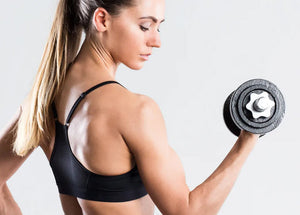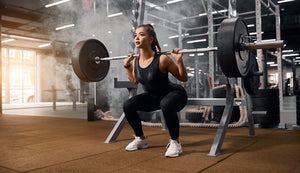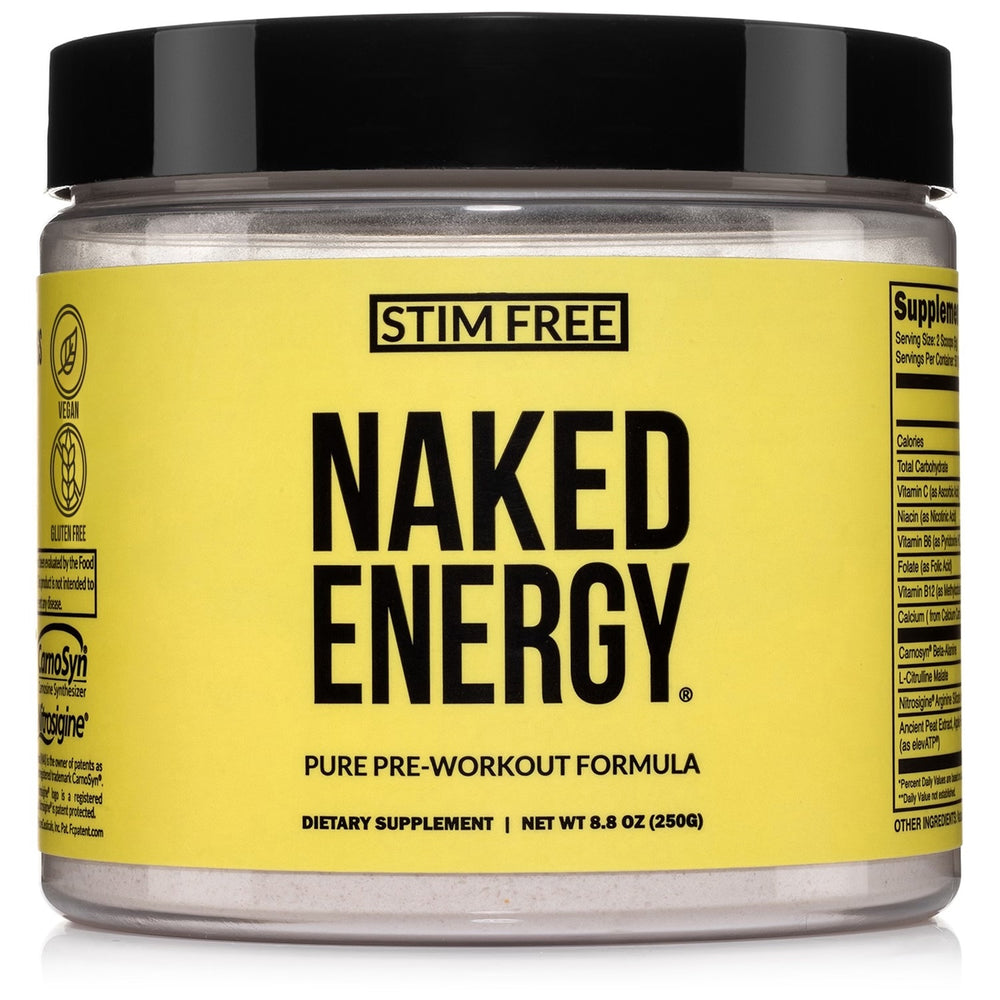The good mornings exercise is a powerful and versatile exercise, which almost anyone can benefit from adding to their workout routine.
Good mornings, plus good morning exercise variations, have amazing benefits for strength and mobility on your posterior chain, including your glutes, hamstrings, back, and core.
In this article we're going to explain why you should be doing good mornings, and why they have a bad rap as being dangerous. We'll show you how to do good mornings safely, and how to add them into your workout routine.
What is the Good Morning Exercise?
The good morning exercise is also known as a hip-hinge, which gives you a good idea of how it works.
A good morning is a mix between a squat and a deadlift. Like a squat, you have a barbell or light weight loaded on your back. But the movement is similar to a deadlift, where you keep your spine straight, contract the hips and bend forward.
You can also imagine it as the movement you do when you get out of bed in the morning, putting your feet on the floor, bending at the waist, before straightening out and standing up. Hence where the “good morning” name comes from.
How to Do the Good Morning Exercise?
Take a similar starting position to a squat, with knees slightly bent and feet hip-width apart, toes pointed forward.
If you're doing a barbell good morning, have the bar resting across your traps/rear delts (not on your neck), with your hands keeping it in place. If you're doing it unweighted, put your hands gently behind your head, interlocking your fingers.
Fix your knees in place with a slight bend - they shouldn't bend further during the movement.
Lower the weight by putting your chest forward and pushing your hips and butt back. Keep your spine straight and hinge forward at the hips. Sit into the movement, and keep your chest in line with your knees.
After descending to around a 15-degree angle, come back up to the starting position.
Check out this video to see the perfect good morning form in action:
Why Should You Do the Good Morning Exercise?
Compound movements like squats and deadlifts are so valuable for the full-body workout they give you, as well as strengthening the oft-neglected posterior chain.
Good mornings are no different. Barbell good mornings in particular hit a number of muscle groups at once, primarily the glutes and hamstrings, but also the calves, upper back, lats, and core muscles.
The shoulders, biceps and triceps can also be activated with a barbell good morning, giving you a ton of benefits from just one exercise.
Building posterior chain strength has amazing benefits for functional strength, mobility, power and all-round athleticism, which benefits just about everyone, regardless of their workout goals. Increasing functional strength and mobility helps you lift more, move faster, and avoid injuries, both from working out and regular day-to-day activities.
Another huge plus of the good morning is its versatility. You can do barbell good mornings as a strength exercise, or do unweighted good mornings to improve hip flexibility or as a warm up before doing another hip hinge exercise (e.g. squats).
Good mornings make sense for just about everyone. The key is just to learn the proper technique so you minimize any risk.
Are Good Mornings Bad for Your Back?

Good mornings have a bad reputation. A lot of people think they're bad for your back, and if you look at the movement, you can understand why they would.
If you do it with poor form, there's definitely a risk of injury. But the good morning is actually beneficial for your back, assuming you maintain good form.
When you build strength and mobility along the entire body, especially in the posterior chain, you build an incredible foundation of supporting muscles all along the spine.
This not only strengthens the back, but helps you avoid lower back injuries from other exercises or movements (e.g. barbell squats).
When you lack strength in these areas, your back, particularly the lower back, often has to compensate and take on more weight, which is where injuries occur.
Are Good Mornings Dangerous?
Now we get to the biggest concern around the good morning exercise.
They have a reputation for being dangerous, due to the way a barbell good morning looks, with a large weight loaded on your back, bent at the waist looking like a failed squat.
It looks like an injury waiting to happen. But the good news is, the good morning is perfectly safe, as long as you use correct technique.
To be fair, there is a small margin for error with this exercise - get it wrong, and you can do some damage.
However, learning to do good mornings correctly is not too difficult. And when done right, good mornings are not only safe, they'll strengthen both your lower and upper body in a way that helps you avoid injuries, as we talked about earlier.
How to Do Good Mornings Safely

Learning to do safe, form-perfect good mornings is essential. Here are a few tips to help you do them with correct form, without risk of injury.
Keep your back straight
It's essential that your back doesn't round during the movement, and remains straight. When you bend your spine, you put a lot of stress on the lower back, especially with a weighted good morning.
Engage your core and use these muscles to keep your back straight the whole way through the movement pattern. If you can't do this, go with a lower weight.
Don't bend too far forward
One of the most common good morning mistakes is bending too far forward and overbalancing.
You want to keep your head over your knees at all times. As you do the movement, hinge at the hips, lower your upper body and shoot your hips back.
The common mistake is not shooting your hips back, and instead leaning forward, where you don't utilize your lower body enough and put too much strain on the lower back.
Go easy on the weight
Stick to light weights with good mornings. Most problems come when you try to do a good morning with too much weight.
When you're first learning the form, start with the absolute minimum in weight. Begin with just an unloaded barbell, or even nothing at all. Work at getting correct and consistent form, and only when you're absolutely confident, start adding weight.
Work with a trainer if possible
Since form is so crucial with good mornings, it's best to work with a trainer if you can. A trainer will show you the correct form, and observe you help keep your form perfect.
What if I Don't Have Enough Mobility to Perform Good Mornings?

Mobility - or lack of it - may feel like a hurdle for some people when it comes to first adding good mornings to your routine. It's true that you might have trouble with this exercise if you have poor mobility, but that's just more of a reason to start doing good mornings regularly.
Good mornings will improve your mobility, which will do wonders for many areas of your life, whether it's improving athletic performance, how well you execute other lifts, or just feeling better in everyday life.
If you're starting from a point of poor mobility, begin with unweighted good mornings. You won't have as much risk of damaging your lower back, and you'll gradually work your way up to a full range of motion.
Supplementary mobility routines can also help here, such as daily stretching, and yoga.
You can also use a stick to help with mobility and learning proper form for good mornings. This video shows how to do this:
What are the Different Good Morning Variations?
There are a number of variations to the good morning exercise that alter the level of difficulty and/or the primary muscles worked.
Unweighted good mornings
These are done with zero weight, are great for mobility and carry a lower risk of injury. This is a great place to start when you're new to this exercise. The movement pattern is no different to what we've discussed earlier, you just connect your hands behind your head instead of loading a weight across your shoulders.
Back-loaded good mornings
Back-loaded barbell good mornings are the standard way to do a good morning. You can load a weight on your back like with a squat (but with much less weight than you would squat with), or just load an empty barbell.
Weighted good mornings are an excellent all-round strength workout, but it's important to master your form with unweighted or light-weight good mornings before you start adding plates.
Front-loaded good mornings
You can move on to a more difficult alternative with a front-loaded good morning.
With this variation, you hold a weight in front of you, instead of loading it on your back. It can be a barbell (cradled in your arms, like a front squat), or another type of weight, such as a plate, dumbbell or kettlebell.
This puts more emphasis on keeping the core engaged to keep your spine straight and form correct. Be sure to start with very light weights with this variation, so you're not tempted to round your back.
Seated good mornings
The seated good morning variation works the glutes and lower back more, while being easier on the hamstrings.
As the name suggests, you start in a seated position, feet planted shoulder width apart and barbell loaded on the back. Then perform the exercise as normal, bending at the waist, keeping your back straight.
The seated good morning is a great alternative for people with knee injuries, as it allows you to lessen the load on your joints in the lower body.
Single-legged good morning
When you've nailed down your form, you can also try a single-legged good morning, balancing on one leg and performing the same hip-hinge movement. You'll want to keep the load extremely low for this, which is a great challenge for stability and balance.
How to Include Good Mornings in Your Workout Routine

Good mornings are not suitable for HIIT or metabolic conditioning routines, where intensity and speed are the goals. A good morning must be precise, and smooth, with each rep done perfectly. So you don't want to be racing to complete the movement.
There are two ways to think of good mornings as part of your routine.
They can be great as a warm-up at the start of your workout. Do a set of light or unweighted good mornings to work on your mobility and stretch out muscles that you're going to put into use later.
Alternatively, good mornings make a fine addition to your strength routine. It's still essential to keep the weight low until you've got your form nailed down, however, even a low weight will give you a deep burn in the hamstrings, making them perfect for a grueling leg day.
Final Thoughts
Good mornings are a powerful exercise for a number of reasons, including the efficiency with which you can work many different muscle groups and the benefits this exercise offers your core and posterior chain. It's unfortunate that many people see the movement as dangerous, and thus don't add it to their regular routine.
Take the time to learn the perfect form for good mornings, and start utilizing them now. You'll see massive benefits that carry over into other lifts, athletic performance, and feeling great in daily life.










